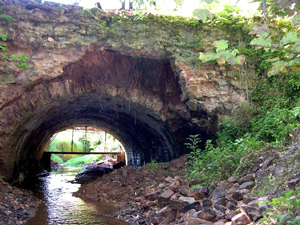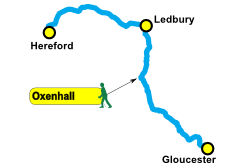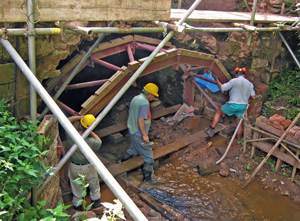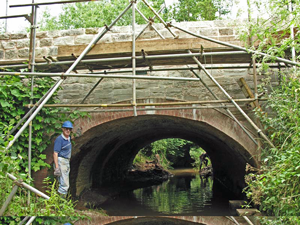Following completion of the restoration work on House Lock during the summer in 2003, the Trust’s Oxenhall team was able to turn their attention to restoration of the Ell Brook Aqueduct.

 Although it was known that both faces of the aqueduct were in poor condition, the fully severity of this was not established until loose stonework had been made safe and the vegetation covering the structure had been removed. The Trust was assisted with this early work by the Waterways Recovery Group, who regularly assist the Trust’s own volunteers at Oxenhall and elsewhere along the canal.
Although it was known that both faces of the aqueduct were in poor condition, the fully severity of this was not established until loose stonework had been made safe and the vegetation covering the structure had been removed. The Trust was assisted with this early work by the Waterways Recovery Group, who regularly assist the Trust’s own volunteers at Oxenhall and elsewhere along the canal.
Following removal of the vegetation a full structural inspection was undertaken, and the Trust were able to erect a Bailey Bridge across the top of the aqueduct to enable vehicles to cross the stream without overloading the weakened structure. The components forming the bridge structure was kindly donated to the Trust by the army, and were sufficient to enable a further, smaller bridge to be erected over the river lock at Over.
During 2004, work concentrated on taking down the defective masonry, and on recovering fallen material from the watercourse beneath and downstream from the structure.
 In 2005, specially designed and fabricated steel centring was erected onto temporary foundations in the bed of the stream below the upstream face of the aqueduct, and a series of timber packs placed to enable the precise profile of the original arch to be reconstructed. This work was undertaken with further assistance from the WRG.
In 2005, specially designed and fabricated steel centring was erected onto temporary foundations in the bed of the stream below the upstream face of the aqueduct, and a series of timber packs placed to enable the precise profile of the original arch to be reconstructed. This work was undertaken with further assistance from the WRG.
With the centring in place, the arch barrel was rebuilt to its original extent in red engineering brickwork, and then work to reinstate the spandrel wall above was able to progress. Initially, stone recovered on site was used, but it quickly became apparent that much of this had been lost, so suitable stone from a demolished railway bridge was imported to site (with assistance from Herefordshire County Council).
This stone was cut to size before being laid in place, and then strengthened with mass concrete backfill. The steel centring was removed at the end of 2005 and placed into store for for re-use on the downstream face of the aqueduct.
 Whilst work progressed on re-building the spandrel wall, the Trust volunteer’s designed and fabricated more temporary works to enable a hole in the centre of the aqueduct arch barrel to be repaired. The hole, believed to have developed around a former outlet provided to enable the canal pound to be drained, was sealed initially with timber centering winched into place and then bolted in position, and then filled permanently with stone laid from above over the centering (early 2006).
Whilst work progressed on re-building the spandrel wall, the Trust volunteer’s designed and fabricated more temporary works to enable a hole in the centre of the aqueduct arch barrel to be repaired. The hole, believed to have developed around a former outlet provided to enable the canal pound to be drained, was sealed initially with timber centering winched into place and then bolted in position, and then filled permanently with stone laid from above over the centering (early 2006).
During this period, the unstable downstream face of the aqueduct continued to deteriorate, and further collapses of loose masonry had to be dealt with by the Oxenhall team, but it wasn’t until September 2006 that work on the upstream face was sufficiently advanced to enable restoration work to commence on the downstream face.
In 2014 a concrete membrane was laid over the top of the restored aqueduct and the temporary Bailey Bridge removed.
[envira-gallery id=”3673″]




